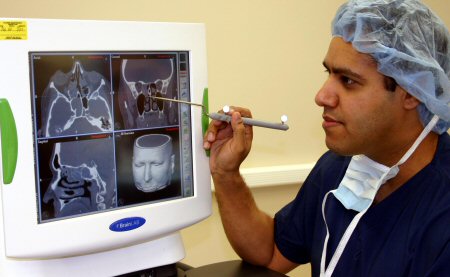Resumo
Definição
História e exame físico
Principais fatores diagnósticos
- presença de fatores de risco
- pressão/dor facial
- obstrução nasal
- secreção nasal/gotejamento pós-nasal
- purulência
- cefaleia
Outros fatores diagnósticos
- fadiga
- tosse
- hiposmia/anosmia
- febre
- halitose
- dor de dente
- dor de ouvido/pressão
Fatores de risco
- disfunção ciliar
- sensibilidade à aspirina
- rinite alérgica
- hiper-reatividade das vias aéreas/asma
- cirurgia prévia dos seios paranasais
- imunodeficiência
- desvios graves do septo
- deformidade da concha bolhosa
- cornetos médios curvados paradoxalmente
- corpos estranhos
- anormalidades craniofaciais
- tabagismo
- poluição ambiental
- sarcoidose
- granulomatose com poliangiite
- história de asma
Investigações diagnósticas
Primeiras investigações a serem solicitadas
- rinoscopia anterior
- endoscopia nasal
Investigações a serem consideradas
- tomografia computadorizada (TC) dos seios da face
- ressonância nuclear magnética (RNM) dos seios nasais
- culturas do seio nasal/sinusais
- teste de alergia
Algoritmo de tratamento
rinossinusite crônica
continuação de sintomas apesar da terapia medicamentosa
Colaboradores
Autores
Raj Sindwani, MD, FACS, FRCS
Section Head of Rhinology, Sinus, and Skull Base Surgery
Head and Neck Institute
Cleveland Clinic Foundation
Cleveland
OH
Declarações
RS is an author of a number of references cited in this topic. RS is a consultant for Optinose, Stryker, and 3D Matrix.
Christopher Roxbury, MD
Associate Professor
Rhinology and Endoscopic Skull Base Surgery
Section of Otolaryngology - Head and Neck Surgery
Department of Surgery
University of Chicago Medicine & Biological Sciences
Chicago
IL
Declarações
CR declares that he has no competing interests.
Agradecimentos
Dr R Sindwani and Dr C Roxbury would like to acknowledge Dr J Antisdel, a previous contributor to this topic.
Revisores
Ryland P. Byrd, Jr, MD
Professor
James H. Quillen College of Medicine
East Tennessee State University
Johnson City
TN
Declarações
RPB declares that he has no competing interests.
Thomas Sanford, MD
Assistant Professor of Otolaryngology - Head and Neck Surgery
St Louis University School of Medicine
St Louis
MO
Declarações
TS declares that he has no competing interests.
Ozgur Yigit, MD
Chief
ENT Department
Istanbul Training and Research Hospital
Istanbul
Turkey
Declarações
OY declares that he has no competing interests.
Christos Georgalas, MD, PhD, DLO, FRCS (ORL-HNS)
Assistant Professor/Consultant
Academic Medical Center
Amsterdam
The Netherlands
Declarações
CG declares that he has no competing interests.
Créditos aos pareceristas
Os tópicos do BMJ Best Practice são constantemente atualizados, seguindo os desenvolvimentos das evidências e das diretrizes. Os pareceristas aqui listados revisaram o conteúdo pelo menos uma vez durante a história do tópico.
Declarações
As afiliações e declarações dos pareceristas referem--se ao momento da revisão.
Referências
Principais artigos
Rosenfeld RM, Piccirillo JF, Chandrasekhar SS, et al. Clinical practice guideline (update): adult sinusitis. Otolaryngol Head Neck Surg. 2015;152(suppl 2):S1-S39.Texto completo Resumo
Peters AT, Spector S, Hsu J, et al. Diagnosis and management of rhinosinusitis: a practice parameter update. Ann Allergy Asthma Immunol. 2014 Oct;113(4):347-85. Resumo
Fokkens WJ, Lund VJ, Hopkins C, et al. European Position Paper on rhinosinusitis and nasal polyps 2020. Rhinology. 2020 Feb 20;58(suppl s29):1-464. Resumo
Artigos de referência
Uma lista completa das fontes referenciadas neste tópico está disponível para os usuários com acesso total ao BMJ Best Practice.

Diagnósticos diferenciais
- Rinossinusite aguda
- Rinite alérgica
- Rinossinusite fúngica alérgica
Mais Diagnósticos diferenciaisDiretrizes
- International consensus statement on allergy and rhinology: rhinosinusitis
- European Position Paper on rhinosinusitis and nasal polyps 2020
Mais DiretrizesFolhetos informativos para os pacientes
Sinusite (aguda)
Mais Folhetos informativos para os pacientesVideos
Como examinar a cavidade nasal
Mais vídeosConectar-se ou assinar para acessar todo o BMJ Best Practice
O uso deste conteúdo está sujeito ao nosso aviso legal